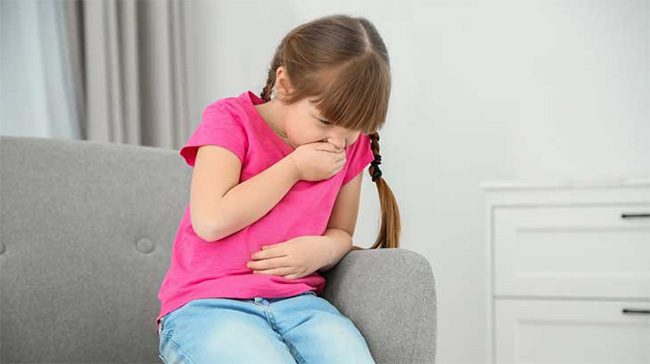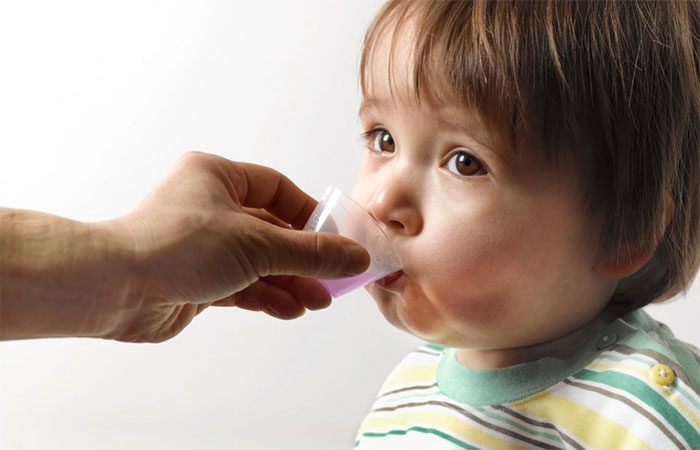Vomiting is a very common symptom in children, especially infants, as their digestive systems are still weak and the valves in the stomach are not yet synchronized.
Typically, children exhibit vomiting symptoms when they encounter gastrointestinal issues. However, this condition can also stem from non-gastrointestinal causes. Vomiting can be a sign of a common ailment or indicate a more serious condition.
Therefore, parents need to understand this situation clearly to decide when they can monitor their child at home and manage the situation appropriately, and when it is necessary to take the child to a healthcare facility.
Causes of Vomiting
According to Dr. Le Bich Lien from Children’s Hospital 1 in Ho Chi Minh City, vomiting can arise from various causes depending on the child’s age.

Vomiting is a common symptom in children. (Illustrative image).
Specifically, in infants and children under 12 months old, common causes include:
- Physiological or pathological gastroesophageal reflux. This is difficult to differentiate, so adults should take the child for examination so that a doctor can diagnose and treat them.
- Surgical conditions such as gastric outlet obstruction, intussusception, intestinal obstruction… If the child vomits excessively or the vomit has an unusual color, parents need to take the child to see a doctor immediately.
- Vomiting accompanied by fever: In this case, the child may have a viral infection, gastrointestinal infection, or infection elsewhere in the body.
- Incorrect feeding or weaning posture.
Meanwhile, for children over 12 months old, causes of vomiting may include:
- Viral infections, gastroenteritis, or food poisoning. This is also the most common cause. At this time, vomiting often starts suddenly and lasts for 24 to 48 hours. Additionally, the child may have other symptoms such as abdominal pain, nausea, diarrhea, and fever.
- Other possible causes include gastroesophageal reflux, peptic ulcer disease, respiratory infections, meningitis, intestinal infections, intestinal obstruction, intussusception, appendicitis…
What to Do When a Child Vomits?
Dr. Lien provides some immediate actions parents can take when their child vomits:
- Turn the child’s head to the side to prevent aspiration of vomit. Quickly clean the vomit from the child’s mouth and nose using a suction device or a finger wrapped in gauze to absorb the vomit. If the child vomits while sleeping, keep them lying still, elevate their head, and tilt them to the side to avoid reflux and aspiration.
- Ensure the child’s body is kept clean.
- Avoid picking the child up abruptly while they are vomiting as this increases the risk of vomit entering the lungs.
Another important note after a child vomits is that parents need to closely monitor signs of dehydration in their child. Some mild signs of dehydration include thirst and slightly dry lips.
“Children with mild dehydration usually do not need to see a doctor immediately. However, parents should closely monitor the situation to detect any signs of more severe dehydration in a timely manner,” Dr. Lien emphasizes.

Rehydration is crucial when a child vomits. (Illustrative image: Pediatrics of Florence).
Specifically, some signs of moderate to severe dehydration include very dry lips, sunken eyes, crying without tears, infrequent urination, cold hands and feet, lethargy, rapid pulse, and cardiovascular shock… When a child exhibits any of these signs, the family must take them to a healthcare facility immediately.
Oral rehydration will be a crucial task at this time. According to Dr. Lien, the best rehydration solution is Oral Rehydration Salts (ORS), which help replenish water and electrolytes (sodium, potassium, chloride) lost due to vomiting and diarrhea. ORS is not used to treat vomiting but helps prevent and treat dehydration.
For children with mild dehydration, parents can give them ORS at home. However, the specialist advises parents to be patient and give the child small sips, spoon-feeding every 1-2 minutes to minimize the risk of vomiting. The amount of ORS the child needs to drink within 4 hours is 50 ml for each kilogram of body weight. (For example, a child weighing 10 kg needs to drink 500 ml of ORS).
On the other hand, for children who are not dehydrated or have already shown no signs of dehydration, the family can continue to give them ORS or cooled boiled water between vomiting episodes to prevent dehydration.
It is important to not give children fruit juices or other drinks to rehydrate, such as mineral water with electrolytes, soft drinks, or carbonated beverages.
Regarding the diet, Dr. Lien states that if the child shows no signs of dehydration, the family can continue to feed them normally. However, if the child shows signs of dehydration, after rehydrating for 2-3 hours and if vomiting decreases, we can start feeding them again.
“The principle is to give the child easily digestible liquid foods divided into small portions,” the specialist notes.
Additionally, for children still breastfeeding, families can continue to breastfeed as breast milk is easier to digest than rehydration solutions. However, Dr. Lien recommends breastfeeding in small amounts, multiple times, as children are very prone to vomiting when food enters their mouths.
We should breastfeed for 5-10 minutes, pause for 30 minutes, and then continue breastfeeding. Adults should monitor for about 2-3 hours; if vomiting decreases and the child stabilizes, we can resume normal breastfeeding. If there is no improvement, parents should take the child for examination.
For older children, we should not force them to eat, especially in the first 24 hours. Instead, encourage the child to drink rehydration fluids. Alongside this, parents should offer easily digestible liquid foods such as lean meat porridge, soup, and yogurt… while limiting fatty foods as they are harder to digest.
Since vomiting is a beneficial response that helps the body eliminate pathogens and harmful substances, Dr. Lien advises families to only use antiemetic medications when the child vomits excessively, posing a risk of dehydration or to reduce motion sickness.
However, these medications should only be administered under a doctor’s prescription and should not be given to children without medical advice.
The specialist recommends that families take their child for examination immediately if any of the following dangerous signs appear:
- Infants vomiting excessively, poor feeding, refusing to breastfeed
- Vomiting lasting more than 24 hours
- Vomitus with unusual colors: Blood (red or brown) or yellow-green (bile)
- Signs of moderate to severe dehydration
- Severe abdominal pain
- Blood in stool
- Fever of 38.5 degrees Celsius or higher for 3 days or high fever above 39 degrees Celsius
- Child being lethargic, sluggish, or unusually irritable and crying
- Seizures.
Decoding the Mystery of Ancient Egyptian Ethnicity
Half-a-Billion-Year-Old Monster Appears Intact, Beautiful as a Relief in China
Discovery of a Pair of Rare, Highly Venomous Orange Snakes in a Parking Lot in Australia



















































